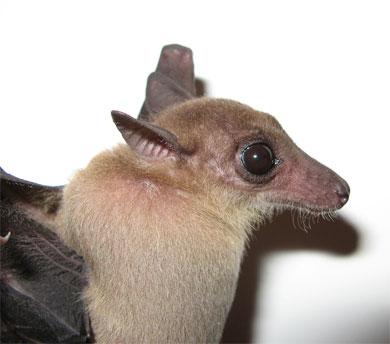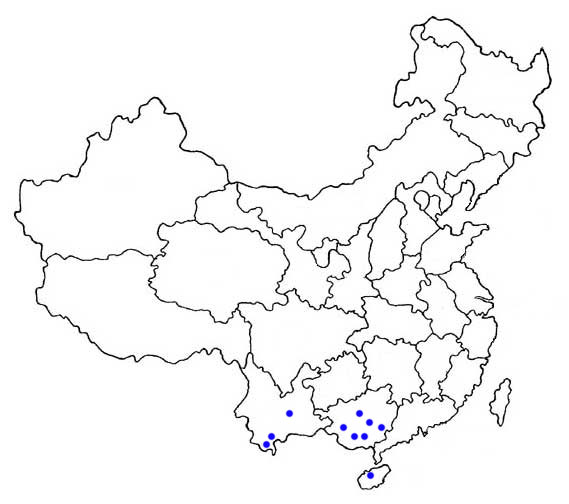Eonycteris spelaea
Lesser Dawn Bat; Dawn Bat; Dobson's Long-tongued Fruit Bat; Cave Fruit Bat
Morphological description Life history Distribution Habitat Roost sites and roosting patterns Emergence and flight pattern Foraging behaviour Echolocation calls Status and protection

Morphological Description
· Dorsal fur is dark brown. Ventral fur is lighter.
· Juveniles are lighter than adults.
· This is a medium-sized fruit bat. Body length 85-115 mm. Average forearm length 72.0 mm (60-80mm). Body mass 0.0539±0.0058 kg, wing span 0.4247±0.0175m, wing area 0.02911±0.00231 (n=11, as given by Hodgkison et al . 2004)
· They have long and slender snouts. The lesser dawn bat's tongue is long. They lack a claw on the second digit (claw present on thumb).
Life history
· After two years, males reach sexual maturity, female need one year, and give birth at any time of the year. Krutzsch (2005) confirmed that this species is aseasonal and polyestrous, females are monotocous with two pregnancies a year.
· Usually a single pup is born.
Distribution
Found in India, South China through to the Andaman Islands, Malaysia, Sumatra, Java, Borneo, Bali, Lombok, Sumba, Timor, Sulawesi, Moluccas, and several islands in the Philippines (Corbet & Hill1992).
The Chinese distribution is shown by dots on the map below (as given by Zhang et al. 1997).

Habitat
· Rainforests are important for them: for example in China, this species live is the Xishuangbanna rainforests, southern Yunnan Province.
Roost sites and roosting behaviour
· They roost in limestone caves or small shelters.
· Occasionally they roost in deserted houses.
· This species often share their roosts with other bat species. We found lesser dawn bats roosting with Chaerephon plicata.
Emergence and flight pattern
· Nocturnal. Emerges at dusk.
· This bat is mainly active in open airspaces above the forest canopy (Hodgkison et al . 2004).
Foraging behaviour
· Forages at above the forest canopy to feed on the fruits and flowers of large emergent trees and strangler figs (Hodgkison et al . 2004).
· The diet mainly consists of fruits and flowers but is unknown in detail.
Echolocation calls
This species does not emit echolocation calls.
Status and protection
· There is no estimation of population size for China.
· Lesser dawn bats are at LR/lc, assessed by the Red List of Threatened Species (IUCN, 2007) and are not listed in the Law of the People's Republic of China on the Protection of Wildlife in 1989.
· Caves and old buildings should be protected as their habitats.